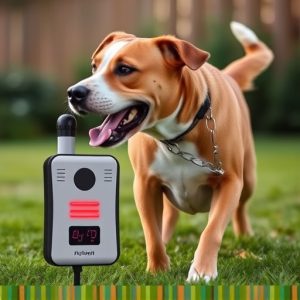Sonic Dog Training: Safe Frequencies for Effective Behavioral Correction
Sonic dog training, utilizing ultrasonic behavioral correction (23-64 kHz), offers a humane method t…….
Sonic dog training, utilizing ultrasonic behavioral correction (23-64 kHz), offers a humane method to correct unwanted canine behaviors like barking or pulling on leashes. This technique focuses on positive reinforcement and specific commands, ensuring pets' safety and comfort. By using safe ultrasonic frequencies, owners can guide dogs without fear or pain, fostering better communication. Effective training involves timely application during behavior, paired with commands and positive reinforcement. Reputable devices from brands that use safe frequencies (22-52 kHz) should be used briefly and responsibly for optimal results.
“Explore the revolutionary world of sonic dog training, a modern behavioral correction method gaining traction among canine enthusiasts. This article delves into the science and safety behind using ultrasonic frequencies to train dogs effectively. From understanding the basics to implementing best practices, we uncover why this approach is gaining popularity as a humane alternative for positive reinforcement. Discover the precise safe ultrasonic frequencies tailored for canine control, ensuring a harmonious training experience.”
- Understanding Sonic Dog Training: Unveiling the Basics
- Safe and Effective Ultrasonic Frequencies for Canine Correction
- The Science Behind Behavioral Modification with Sound
- Implementing Sonic Training: Tips and Best Practices
Understanding Sonic Dog Training: Unveiling the Basics
Sonic dog training, also known as ultrasonic behavioral correction, is a modern approach to canine discipline that utilizes safe ultrasonic frequencies to guide and correct unwanted behaviors. This method employs high-frequency sound waves that are inaudible to humans but can be detected by dogs, serving as a subtle yet effective deterrent. Unlike traditional punishment methods, sonic training focuses on positive reinforcement and gentle guidance rather than fear or pain induction.
The technology behind this innovative training technique ensures that only the dog can hear the ultrasonic tones, making it a humane alternative for correcting behaviors like excessive barking, jumping, or pulling on leashes. By understanding their dog’s triggers and implementing specific commands, owners can effectively communicate desired behavior without causing any discomfort to their pets. This approach not only addresses immediate behavioral issues but also fosters better communication and understanding between the owner and their canine companion.
Safe and Effective Ultrasonic Frequencies for Canine Correction
When considering ultrasonic frequencies for canine behavioral correction, safety is paramount. Unlike traditional shock collars that use electric currents, ultrasonic devices emit high-pitched sounds invisible to humans but uncomfortable for dogs. The key lies in using safe ultrasonic frequencies specifically designed for dog training, typically ranging from 23 to 64 kHz. These frequencies are well above the human hearing range and below typical dog comfort levels, ensuring no physical harm is caused.
Effective correction requires consistent and timely application of the ultrasonic signal. Devices should be used only when the dog displays unwanted behavior, such as barking excessively or jumping on people. Proper training methods involve pairing the sound with an immediate command like “quiet” or “no.” Consistent repetition and positive reinforcement help dogs associate the ultrasonic correction with their misbehavior, leading to improved control without resorting to aversive methods that may cause fear or anxiety.
The Science Behind Behavioral Modification with Sound
The Science Behind Behavioral Modification with Sound
Sonic dog training, a modern approach to behavioral correction, harnesses the power of sound to modify canine behavior. This method utilizes specific ultrasonic frequencies that are inaudible to humans but can be heard by dogs. These safe, high-pitched sounds are designed to capture a dog’s attention without causing any harm or discomfort. By associating certain behaviors with these sonic signals, trainers can effectively communicate and correct unwanted actions.
The technology behind this method is based on the principle that dogs, like many other animals, respond to stimuli in ways that reinforce learning. When a dog exhibits a desired behavior after hearing a specific ultrasonic tone, positive reinforcement strengthens that behavior over time. Conversely, pairing an inaudible sound with unwanted behavior can help deter it by creating a negative association. This scientific approach ensures that training is both effective and safe for the canine companion.
Implementing Sonic Training: Tips and Best Practices
Implementing Sonic Training involves using safe ultrasonic frequencies specifically designed for dog control. These devices emit high-frequency sound waves that are inaudible to humans but can capture a dog’s attention and alter their behavior. When choosing a sonic training device, opt for reputable brands that use frequencies between 22-52 kHz, well above the human hearing range (typically below 20 kHz). This ensures safety and effectiveness without causing harm or discomfort to your pet.
Best practices include using the device in short bursts of 10-30 seconds, only when necessary, and never as a continuous punishment. Always maintain visual contact with your dog during training sessions and ensure they have an escape route if needed. It’s crucial to pair sonic corrections with positive reinforcement techniques, such as treats or praise, to reinforce desired behaviors. Consistency and patience are key; regular, brief training sessions yield better results than infrequent, lengthy ones.
Sonic dog training offers a modern approach to behavioral correction, leveraging safe ultrasonic frequencies to guide canine behavior without harm. By understanding the science behind sound’s impact on dogs and implementing best practices, owners can effectively train their pets while fostering positive relationships. When used responsibly, sonic training can be a game-changer for pet management, ensuring a peaceful and harmonious coexistence between humans and their four-legged friends.


